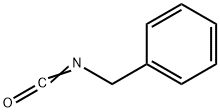Benzyl isocyanide
- CAS NO.:10340-91-7
- Empirical Formula: C8H7N
- Molecular Weight: 117.15
- MDL number: MFCD00000004
- EINECS: 233-738-9
- SAFETY DATA SHEET (SDS)
- Update Date: 2023-06-08 17:06:38

What is Benzyl isocyanide?
Chemical properties
clear colorless to yellowish liquid
The Uses of Benzyl isocyanide
Benzyl Isocyanide is used in the preparation of arylamide compounds. also used as a catalyst in the cycloaddition of norbornenes with internal and terminal acetylenes.
What are the applications of Application
Benzyl isocyanide is Benzyl isocyanide was used in the synthesis of Ru(II) complexes containing hydrazine and benzyl isocyanide ligands. It was used in a three-component coupling process leading to O- and N-arylamides.
What are the applications of Application
Benzyl isocyanide forms phosphaalkene-containing complexes. Benzyl isocyanide was used in the synthesis of Ru(II) complexes containing hydrazine and benzyl isocyanide ligands. It was used in a three-component coupling process leading to O- and N-arylamides.
Synthesis
Synthesis of benzyl isocyanide
In a 500-mL, round-bottomed flask equipped with a magnetic stirring bar and a pressure-equalizing funnel are placed 5-benzylaminotetrazole (10.5 g, 60 mmol), 100 mL of 10% sodium hydroxide solution, and 70 mL of dichloromethane. The mixture is cooled to 0°C and a solution of NaOBr in water (165 mL, 65 mmol) (Note 2) is added with vigorous stirring over a 15-min period (Note 3). The dichloromethane layer is separated and the aqueous phase extracted with five 50-mL portions of dichloromethane. The combined dichloromethane extracts are dried over anhydrous MgSO4, the drying agent is removed by filtration, and the dichloromethane is removed by simple distillation. The pressure is then reduced to ~20 mm with an aspirator and benzyl isocyanide is distilled at 98–100°C; yield: 5.91 g (84%) (Note 4) and (Note 5).
Organic Syntheses, Coll. Vol. 7, p. 27, 1990
http://www.orgsyn.org
Properties of Benzyl isocyanide
| Boiling point: | 105-106 °C75 mm Hg(lit.) |
| Density | 0.962 g/mL at 25 °C(lit.) |
| refractive index | n |
| Flash point: | 175 °F |
| storage temp. | -20°C |
| pka | 27.4 |
| form | clear liquid |
| color | Colorless to Red to Green |
Safety information for Benzyl isocyanide
| Signal word | Warning |
| Pictogram(s) |
 Exclamation Mark Irritant GHS07 |
| Precautionary Statement Codes |
P261:Avoid breathing dust/fume/gas/mist/vapours/spray. P264:Wash hands thoroughly after handling. P264:Wash skin thouroughly after handling. P280:Wear protective gloves/protective clothing/eye protection/face protection. P301+P312:IF SWALLOWED: call a POISON CENTER or doctor/physician IF you feel unwell. |
Computed Descriptors for Benzyl isocyanide
New Products
4,4-Difluoropiperidine hydrochloride tert-butyl 9-methoxy-3-azaspiro[5.5]undecane-3-carboxylate Indole Methyl Resin N-Isopropylurea N,N-Dicyclohexylcarbodiimide(DCC) MELDRUMS ACID 5-METHYLISOXAZOLE-4-CARBOXYLIC ACID Magnessium Bis glycinate Zinc ascorbate 1-bromo-2-butyne 2-acetamidophenol 9(10H)-anthracenone Erythrosin B, 4-Piperidinopiperidine 2-((4-morpholinophenylamino) (methylthio) methylene) malononitrile 2,4-dihydroxybenzaldehyde 3-(4-morpholinophenylamino)-5-amino-1H-pyrazole-4-carbonitrile Methyl 2-methylquinoline-6-carboxylate 2,6-dichloro-4-nitropyridine 4-Bromo-2-chlorobenzonitrile 2-(benzylamino)acetic acid hydrochloride 4-(tert-Butoxycarbonylamino)but- 2-ynoic acid 3,4-dihydro-2H-benzo[b][1,4]dioxepine 1-Phenyl-1-cycloprppanecarboxylicacidRelated products of tetrahydrofuran








You may like
-
 10340-91-7 Benzyl isocyanide 98%View Details
10340-91-7 Benzyl isocyanide 98%View Details
10340-91-7 -
 Benzyl isocyanide 95% CAS 10340-91-7View Details
Benzyl isocyanide 95% CAS 10340-91-7View Details
10340-91-7 -
 Benzyl Isocyanide CAS 10340-91-7View Details
Benzyl Isocyanide CAS 10340-91-7View Details
10340-91-7 -
 3-(4-amino-1-oxoisoindolin-2-yl)-1-methylpiperidine-2,6-dione 98%View Details
3-(4-amino-1-oxoisoindolin-2-yl)-1-methylpiperidine-2,6-dione 98%View Details -
 20677-73-0 (2,2-diethoxyethyl)methylamine 98%View Details
20677-73-0 (2,2-diethoxyethyl)methylamine 98%View Details
20677-73-0 -
 3-(4-(hydroxyamino)-1-oxoisoindolin-2-yl)piperidine-2,6-dione 98%View Details
3-(4-(hydroxyamino)-1-oxoisoindolin-2-yl)piperidine-2,6-dione 98%View Details -
 57381-49-4 2-bromo-4-chlorobenzonitrile 98%View Details
57381-49-4 2-bromo-4-chlorobenzonitrile 98%View Details
57381-49-4 -
 4,6-dichloropyrimidine-5-carbaldehyde 98%View Details
4,6-dichloropyrimidine-5-carbaldehyde 98%View Details
5305-40-8
